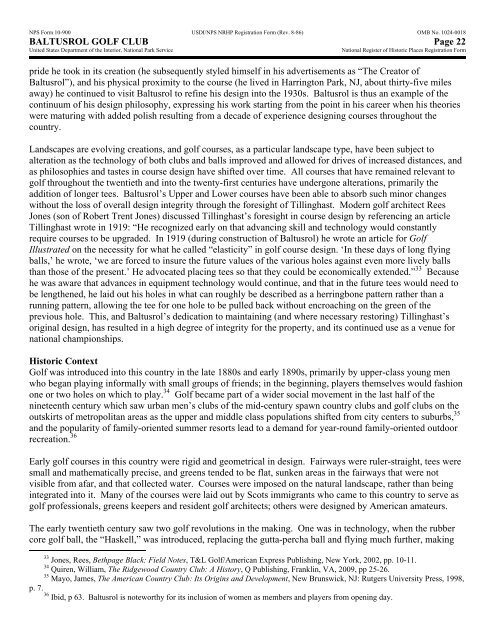Nomination - National Park Service
Nomination - National Park Service
Nomination - National Park Service
Create successful ePaper yourself
Turn your PDF publications into a flip-book with our unique Google optimized e-Paper software.
NPS Form 10-900 USDI/NPS NRHP Registration Form (Rev. 8-86) OMB No. 1024-0018<br />
BALTUSROL GOLF CLUB Page 22<br />
United States Department of the Interior, <strong>National</strong> <strong>Park</strong> <strong>Service</strong><br />
<strong>National</strong> Register of Historic Places Registration Form<br />
pride he took in its creation (he subsequently styled himself in his advertisements as “The Creator of<br />
Baltusrol”), and his physical proximity to the course (he lived in Harrington <strong>Park</strong>, NJ, about thirty-five miles<br />
away) he continued to visit Baltusrol to refine his design into the 1930s. Baltusrol is thus an example of the<br />
continuum of his design philosophy, expressing his work starting from the point in his career when his theories<br />
were maturing with added polish resulting from a decade of experience designing courses throughout the<br />
country.<br />
Landscapes are evolving creations, and golf courses, as a particular landscape type, have been subject to<br />
alteration as the technology of both clubs and balls improved and allowed for drives of increased distances, and<br />
as philosophies and tastes in course design have shifted over time. All courses that have remained relevant to<br />
golf throughout the twentieth and into the twenty-first centuries have undergone alterations, primarily the<br />
addition of longer tees. Baltusrol’s Upper and Lower courses have been able to absorb such minor changes<br />
without the loss of overall design integrity through the foresight of Tillinghast. Modern golf architect Rees<br />
Jones (son of Robert Trent Jones) discussed Tillinghast’s foresight in course design by referencing an article<br />
Tillinghast wrote in 1919: “He recognized early on that advancing skill and technology would constantly<br />
require courses to be upgraded. In 1919 (during construction of Baltusrol) he wrote an article for Golf<br />
Illustrated on the necessity for what he called “elasticity” in golf course design. ‘In these days of long flying<br />
balls,’ he wrote, ‘we are forced to insure the future values of the various holes against even more lively balls<br />
than those of the present.’ He advocated placing tees so that they could be economically extended.” 33 Because<br />
he was aware that advances in equipment technology would continue, and that in the future tees would need to<br />
be lengthened, he laid out his holes in what can roughly be described as a herringbone pattern rather than a<br />
running pattern, allowing the tee for one hole to be pulled back without encroaching on the green of the<br />
previous hole. This, and Baltusrol’s dedication to maintaining (and where necessary restoring) Tillinghast’s<br />
original design, has resulted in a high degree of integrity for the property, and its continued use as a venue for<br />
national championships.<br />
Historic Context<br />
Golf was introduced into this country in the late 1880s and early 1890s, primarily by upper-class young men<br />
who began playing informally with small groups of friends; in the beginning, players themselves would fashion<br />
one or two holes on which to play. 34 Golf became part of a wider social movement in the last half of the<br />
nineteenth century which saw urban men’s clubs of the mid-century spawn country clubs and golf clubs on the<br />
outskirts of metropolitan areas as the upper and middle class populations shifted from city centers to suburbs, 35<br />
and the popularity of family-oriented summer resorts lead to a demand for year-round family-oriented outdoor<br />
recreation. 36<br />
Early golf courses in this country were rigid and geometrical in design. Fairways were ruler-straight, tees were<br />
small and mathematically precise, and greens tended to be flat, sunken areas in the fairways that were not<br />
visible from afar, and that collected water. Courses were imposed on the natural landscape, rather than being<br />
integrated into it. Many of the courses were laid out by Scots immigrants who came to this country to serve as<br />
golf professionals, greens keepers and resident golf architects; others were designed by American amateurs.<br />
The early twentieth century saw two golf revolutions in the making. One was in technology, when the rubber<br />
core golf ball, the “Haskell,” was introduced, replacing the gutta-percha ball and flying much further, making<br />
33 Jones, Rees, Bethpage Black: Field Notes, T&L Golf/American Express Publishing, New York, 2002, pp. 10-11.<br />
34 Quiren, William, The Ridgewood Country Club: A History, Q Publishing, Franklin, VA, 2009, pp 25-26.<br />
35 Mayo, James, The American Country Club: Its Origins and Development, New Brunswick, NJ: Rutgers University Press, 1998,<br />
p. 7.<br />
36 Ibid, p 63. Baltusrol is noteworthy for its inclusion of women as members and players from opening day.
















